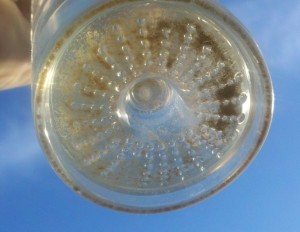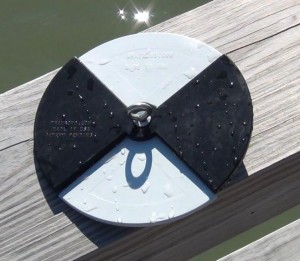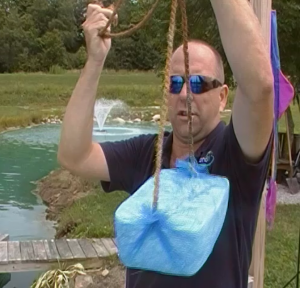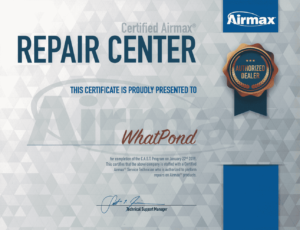
This shows the small amount of clay that can cloud up the pond.
Dirty pond water can be a pain and ruins the fun of seeing the fish, is it actually murky, cloudy, turbid or dirty water is the first to figure out. A newly built pond will be cloudy as the rain washes clay particles and dirt into the pond. Once the pond is full and grass has grown around the pond, including the watershed the water will continue to be cloudy.
Another look that a pond can have is a brown, maybe tea sort of tint when you look out across the water surface but looking down into the water the water is clear. Most likely there are a lot of trees surrounding the pond and fallen leaves can produce a tint to color the pond this way.
Green colored water can tell us we are having an algae bloom, not too bad of a thing for the fish but but generally not the goal most of us pond owners want. Algae blooms can be green, brown even reddish depending on the pond location and type of algae. And you’ll notice decreasing water clarity. Water Clarity can be monitored using a Compact Secchi Disc.
Then there are the times the water is clear once the ice melts and looks good for a while. Then almost overnight it will become cloudy. Discovering the source is difficult but a couple ideas come to mind. Once the water temp. get’s warmer the fish become more active even spawning activities could cloudy the water. Another possibility is a spring pushing through clay or loosening clay to be put out into the water column.
A rain or thunderstorm event can also change the clarity of the water. From the incoming nutrients, the pounding action along the shore line even changing the water chemistry whether by dilution or the rain could be acid rain.
Good news about dirty pond water, cloudy or turbid pond water is most all situations can be cured. A new pond will settle out over time but first the watershed needs to have vegetation growing to slow the rain from washing in more clay. If it doesn’t clear after a winter check the next paragraph.
For the green water, algae blooms and tea colored water Pond Dyehttps://www.whatpond.com/product/super-concentrated-pond-and-lake-dye/ can be used to color the water and reduce sunlight from the algae that need it to live. Adding beneficial pond bacteria, will help to eat up the decaying debris (muck) and the nutrients the decaying debris releases into the water column.
 Back to the clay not settling out of the pond. We have new products to help clean up the water column coming so, please check back or shoot us an email.
Back to the clay not settling out of the pond. We have new products to help clean up the water column coming so, please check back or shoot us an email.


Comments on this entry are closed.
Hi I have a small pond that I build 30 years ago that holds about 300 fish 20 are koi.The oldest is 25 years. The ponds is about 90,000 GAL. We have a seasonal brook that runs 5 months a year off and on. The pond is 8 feet deep. It seems to be very silty and the bottom mucky. I have a fountain and a bottom aerator. The bottom aerator I have not used much because it is making the pond worse as it moves all the silt off the bottom. We test the water every two weeks and everything seems good. We do loose a fish or two every few weeks but never the koi.
Does anything eat all the muck without hurting the fish so I can run the aerator?Will the silty brown water hurt the koi breathing or gills
Thanks
David
HI David,
Let’s start with the little brook that feds the pond. In heavy rains do you notice the water being a little cloudy? This could be a source for the sediment, brownish colored water, leave will also give the pond water a tint as well.
WE use Muck and Sludge Remover for the bottom of the pond debris. It is not an over night process but will continue to work on the muck as long as the product is applied weekly or bi-weekly depending on how fast you want to remove the muck. It is safe for the fish and wildlife around the pond since it is a natural beneficial pond bacteria.
The Koi seem to be able to handle the cloudy water since they are most likely the ones digging in the bottom and stirring up some or the cloudiness in the pond. If you have game fish they would be more susceptible in harm from the cloudy water but it all depends on how thick the water is.
As for the aerator I would get that going again. If it stirs up the bottom I would get in the pond and get the diffuser raised up two feet off the bottom to get it out of the fine stuff. If you didn’t want to get in the pond you could tie a float and have the diffuser suspended from the float to keep it off the bottom.
Why I say it is important to get the diffuser up and running is the fish load you have in the pond, the pond is a little over loaded with 300 fish and possibly the fish are starving for oxygen. Below is a few different ways to figure the fish load for the pond size.
One 6″ fish for every hundred gallons of water OR
1″ of fish per 10 gallons of water OR
Total gallons of pond divided by 200 = Total 6″ fish in pond
Hope this helps?
Darrell
I have a 1 acre foot clay lined pond with 8000sf of surface area. Steep sides and 10′ deep. I have both goldfish and koi, and multiple aerators. I only have several inches of visibility and need to get the water cleared up. I’m suspecting the fish are stirring up the clay. Other than adding tons of gravel, or a liner, is there another solution? Would I need to coat the sides from top to bottom, or do the fish root around that deep?
HI John, Yes Koi are like pigs in water. They will root around from top to bottom depending on what they are looking for.
Gravel would be cheaper than a liner but if the sides are that steep the gravel may just roll tot he bottom of the pond.
If you are sure it is sediment or clay particles we do have a product to settle out the particles but it very well could happen again when the fish get active and could stir things back up again, then you may need to re-apply. The product is a Flocculant which works like a magnet, attracts the particles and once it becomes heavy enough it sinks to the bottom. Along with clay particles there could be suspended organic debris in the water which the pond bacteria products will help to remove.
Hope this helps
Darrell